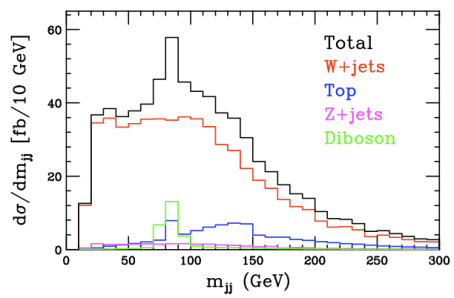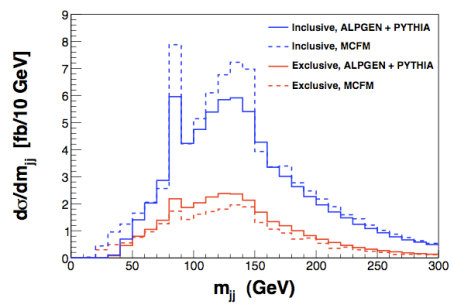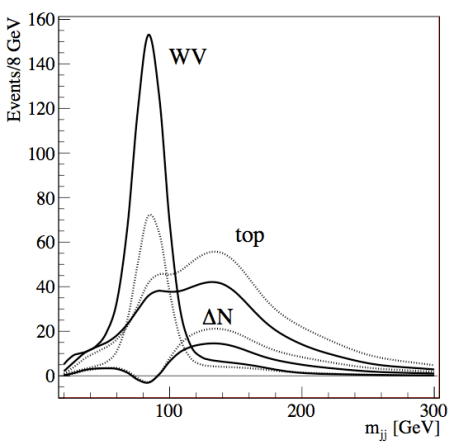Top background shapes and the CDF MJJ Anomaly
June 12, 2011 at 8:05 am 2 comments
The CDF di-jet anomaly has justly received a lot of attention both in the blogosphere and in the professional scientific press. If real, it would be the biggest discovery in particle physics in several decades.
As discussed on many blogs, from Peter Woit and Adam Falkowski through Sean Carroll and Tommaso Dorigo, the D0 Collaboration released results which appear to refute any claims of new physics in the CDF data. So the question is: how do we explain the CDF bump?
Within the LHC community, a lot of discussion centered on the jet energy scale. If one rescales the energies of the jets, the bump can be accommodated and the description of the W peak improved, but the size of the rescale factor is a bit too large given the knowledge of the calorimetry and the physics of jets. Tommaso has written clearly about this, early on. So I don’t expect this to be the main explanation.
A better possibility, in my opinion, is that the background shapes are not accurate enough. Of course the CDF and D0 collaborations use the best tools available to them, but that does not mean that those tools cannot lead to bad background estimates.
An interesting study was recently posted by Campbell, Martin and Williams from the Fermilab theory group (arXiv:1105.4594, 23-May-2011). I think this paper has not received enough attention. The authors checked the difference between leading-order (LO) parton-shower predictions for the sizes and shapes of the backgrounds to next-to-leading order (NLO) prediction.
They confirmed that the requirement of exactly two jets in the event does reduce the top background significantly, and in that basic sense is a useful cut. Unfortunately, it also increases the systematic uncertainties on the background predictions.
The authors changed the requirement of exactly two jets to at least two jets, as part of their study. The top background is larger by a factor of seven, and has a peaking structure around 150 GeV. Here is the plot from their simulation:
Note the broad peak in the top background (blue histogram). This peak coincides with the mass of the CDF anomalous peak. Keep in mind, however that these cuts are not the same as the CDF cuts – the requirement on the number of jets is looser, allowing a lot more top background.
The authors make an additional comparison of the shape of the top background, still with the looser jet requirement. They find that the MCFM Monte Carlo program gives rise to a more peaked version of the top background than the ALPGEN + PS Monte Carlo program used by CDF:
The distinction is less impressive, however, for the tighter jet cuts (red histograms). The predictions for the normalization of the backgrounds are very similar for the two Monte Carlo programs.
They also checked the main background, W+jets, and found no important shape differences.
Finally they conclude that large enhancements due to missing higher orders cannot explain the CDF anomaly, and that the background shape should be smooth in the MJJ region around 150 GeV. So they do not claim to explain the CDF results on the basis of standard model processes, but for me, they do point out that the shape of the top background is somewhat uncertain and happens to peak in the 150 GeV region.
One of the earliest suggestions that top backgrounds may be to blame for the CDF anomaly was made by Plehn and Takeuchi (arXiv:1104.4087, 20-April-2011). Below is a plot showing one of their results. ΔN is an estimate of the change in the background if the WV and top backgrounds are rescaled in mimicry of a systematic error.
The shifts in background normalization are not small, however, but the authors believe they can be accommodated especially through single-top production. They also point to a lack of theoretical understanding of the jet survival probabilities – important for estimating the amount of top background which survives the Njet=2 requirement.
A paper by Sullivan and Menon (arXiv:1104.3790, 19-April-2011) comes to very similar conclusions.
It is not obvious that problems with the top backgrounds explain the CDF anomaly, but the issues raised – especially as regards jet vetos – are serious, and instructive for searches at the LHC.
Entry filed under: Particle Physics.
2 Comments Add your own
Leave a comment
Trackback this post | Subscribe to the comments via RSS Feed



1. anonymus | June 12, 2011 at 8:20 am
anonymus | June 12, 2011 at 8:20 am
You realize that the paper by Campbell, Martin and Williams fully refutes the claims of the Sullivan/Menon work? They explicitly show that the large K factors imagined by Sullivan/Menon are not there if one does the NLO calculation.
Further, the inclusive vs. exclusive distributions look almost identical (both show the bump) and therefore also refute the claim that the uncertainty due to the jet veto is the problem.
I am not claiming that it can’t be a mis-modeled background, just that the points raised in the cited papers (and your post) are not convincing.
2. Walter Giele | June 12, 2011 at 10:10 pm
Walter Giele | June 12, 2011 at 10:10 pm
Interesting, so experimenters at the LHC suspect the jet energy scale? Would a large shift not cause problems with the data from which the JES was extracted?
Also, D0’s analysis of the W+2 jets was done with a separate quark and gluon jet JES. I cannot remember this has been done before…
As for jet vetoes, from a theory point of view I would say avoid whenever possible. At NLO they cause logs with as an argument something like E_veto/H_t.
You can control the logs by scaling the E_veto with H_t (E_veto=c*H_t). By lowering c in data and Monte Carlo, you can study in detail how the modelling and data behave as c gets smaller and smaller…… In general I would say a scaled jet veto is by far more preferred than a fixed jet veto.